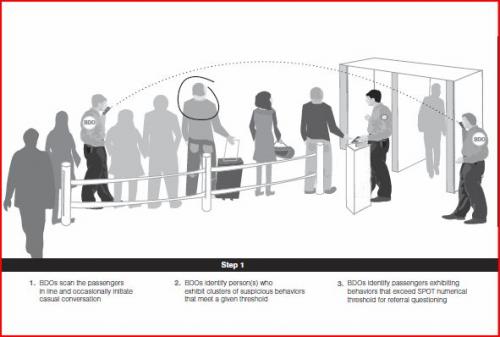Terrorists Slip Past TSA's Scientifically Untested Behavioral Threat Detection Program
05/21/2010 -At least 17 suspected terrorists have evaded federal officers trained to spot suspicious behavior or signs of deception under an aviation security program the Government Accountability Office (GAO) describes as scientifically unreliable.
The GAO reports that the Transportation Security Administration (TSA) deployed the Screening of Passengers by Observation Techniques (SPOT) program "without first validating the scientific basis for identifying suspicious passengers in an airport environment (.pdf)."
Rep. John Mica (R-FL), the ranking member of the House Committee on Transportation and Infrastructure, seized on the report as one more instance of TSA ineffectiveness and waste. In a letter addressed to Homeland Security Secretary Janet Napolitano yesterday,Mica urged the secretary (.pdf) "to initiate immediate efforts for the reevaluation and reorganization of the entire TSA, a bureaucracy that has ballooned in size and cost, and ... is teetering on the verge of disaster."
Rep. Mica also assailed the SPOT program's effectiveness, noting 17 suspected terrorists moved through eight SPOT airports on at least 24 different occasions. One of those suspected terrorists was the failed Times Square bomber Faisal Shahzad, who made it onboard an Emirates flight to Dubai at New York City's JFK Airport earlier this month, despite being on the terrorist watchlist and passing through a security checkpoint where the SPOT program operates. Federal authorities arrested Shahzad onboard the flight before it could take off.
Currently, there are about 3,000behavioral detection officers (BDOs) deployed at 161 of 457 TSA-regulated airports, which cost taxpayers about $212 million this year, according to the GAO. The White House has asked for $232 million next year to expand the SPOT program. If Congress agrees and maintains this funding level, the program would cost approximately $1.2 billion over the next five years.
Under the SPOT program, TSA trains BDOs to walk the airport security line and observe passengers waiting to reach the security checkpoint. Usually working in teams of two, BDOs assess whether passengers are acting suspiciously and then score certain predetermined behaviors on a point system.
"For passengers exhibiting indicators above baseline conditions, the BDOs are to (mentally) add up the points assigned to each indicator they observe," the GAO reports. "Both BDO team members must agree that observed indicators have exceeded the predetermined numerical threshold," and if they do a passenger can be chosen to undergo secondary screening.
On average, BDOs have 30 seconds to observe passengers standing in the security line and make a determination whether they deserve secondary screening before they reach the checkpoint. Passengers that still provoke concern after secondary screening are referred to a law enforcement officer for further scrutiny, including a possible background check.
But even if BDOs could accurately select passengers exhibiting potentially suspicious behaviors—and the GAO is skeptical they can, especially as fatigue sets in—there is no firm scientific foundation for behavorial threat detection.
The government watchdog notes thata 2008 report from the National Research Council of the National Academy of Sciences concluded that there was no scientific consensus behind using behavioral detection techniques to identify potential terrorists. The report goes on to state that even if behavioral detection techniques could accurately pick out evidence of deception or specific emotional states, the practitioner could not know the reason behind the irregular behavior.
"A person exhibiting nervousness may be excited about meeting someone at the airport or about being late. A person lying about his or her travel plans may be concealing an extramarital affair. A person fidgeting may be experiencing back pain," the reportProtecting Individual Privacy in the Struggle Against Terrorists observes. "None of those persons would be the targets of counterterrorist efforts, nor should they be—and the possibility that their true motivations and intents may be revealed has definite privacy implications."
Both the TSA and the Science and Technology (S&T) Directorate, the Department of Homeland Security's research and development arm, do not dispute that the SPOT program was implemented before validation, but defend the program by arguing no behavioral threat detection program, whether domestic or international, has been scientifically validated. Instead, S&T officials based the program's effectiveness on unpublished studies from DHS and defense and intelligence communities, but could not tell GAO investigators the sources of this research.
Despite the program being on shaky scientific ground at best, the GAO reports TSA defied government protocols and deployed SPOT without conducting a cost-benefit analysis. "Although the DHS and OMB guidance recommend that a cost-benefit analysis be conducted prior to deploying a program nationwide—and potentially incurring substantial costs—TSA did not conduct such an analysis of SPOT to inform its pilot testing prior to full-scale nationwide deployment," the GAO states.
The TSA's own numbers call into question the program's effectiveness. Between 2004 and 2008, more than 2 billion passengers boarded planes at SPOT airports with BDOs identifying 152,000 passengers for secondary screening, which led to 1,083 arrests. None of those arrested, however, were terrorists or individuals who intended to attack the aviation system. Moreover, since TSA never scientifically tested the SPOT program, there's no way to know whether random screening wouldn't have produced similar or better results, the GAO notes.
Nevertheless, TSA claims the SPOT program is just one of 20 layers of security that makes it extremely difficult for a terrorist to successfully carry out an attack inside the aviation system.
Rep. Mica begs to differ.
"Penetration testing continues to show that even with new screening technology and the SPOT program, the aviation screening system is not working."
♦ Graphic of SPOT process by GAO
♦ Graph of Passenger Boardings at SPOT Airports, May 29, 2004, through August 31, 2008 by GAO
